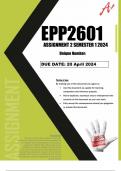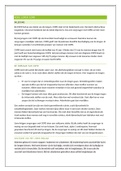EPP2601
ASSIGNMENT 2 SEMESTER 1 2024
Unique Number:
DUE DATE: 20 April 2024
Terms of use
By making use of this document you agree to:
• Use this document as a guide for learning,
comparison and reference purpose,
• Not to duplicate, reproduce and/or misrepresent the
contents of this document as your own work,
• Fully accept the consequences should you plagiarise
or misuse this document.
Disclaimer
Extreme care has been used to create this
document, however the contents are provided “as
is” without any representations or warranties,
express or implied. The author assumes no
liability as a result of reliance and use of the
contents of this document. This document is to
be used for comparison, research and reference
purposes ONLY. No part of this document may be
reproduced, resold or transmitted in any form or
by any means.
, 0688120934
PREVIEW
Question 1
Cultural diversity in the workplace is an important and prevalent aspect of modern
organizations. It refers to the differences in race, ethnicity, gender, age, religion, sexual
orientation, and other aspects of identity among employees. This diversity can bring
many benefits to a workplace, such as a wider range of perspectives and ideas, better
problem-solving abilities, and increased creativity. However, it can also present
challenges, such as communication barriers and misunderstandings. In this essay, I will
reflect on cultural diversity in my workplace and provide practical examples to support
my answers.
One of the most noticeable aspects of cultural diversity in my workplace is the variety of
languages spoken by employees. We have a workforce that comes from different
countries and backgrounds, and this has led to a rich tapestry of languages and dialects
being spoken in the workplace. For example, we have employees from India, China,
and South America, and they bring with them their native languages such as Hindi,
Mandarin, and Spanish. This diversity has made our workplace more vibrant and
inclusive. However, it also poses the challenge of ensuring effective communication
across different language barriers.
Disclaimer
Extreme care has been used to create this document, however the contents are provided “as is”
without any representations or warranties, express or implied. The author assumes no liability as
a result of reliance and use of the contents of this document. This document is to be used for
comparison, research and reference purposes ONLY. No part of this document may be
reproduced, resold or transmitted in any form or by any means.





